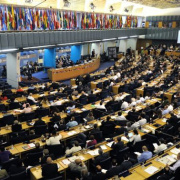Corporate vision of the future of food promoted at the UN
Submitted by Joana Chelo on
La Via Campesina, GRAIN and ETC Group
Fusión entre Syngenta y ChemChina
Submitted by Veronica Villa on
Por 10 años seis multinacionales han controlado el 75% de las semillas híbridas y del negocio de plaguicidas. Dow y DuPont acordaron fusionarse y ahora la empresa paraestatal China, ChemChina está adquiriendo Syngenta. Eso significa que Monsanto necesita una fusión urgente para mantenerse en el juego. ¿O será que el juego está por terminarse?
Sino-Genta?
Submitted by Joëlle Deschambault on
For a decade, six multinationals have controlled 75% of the world’s high-tech seeds and pesticides businesses. Late last year, Dow and DuPont agreed to merge and now state-owned ChemChina is buying Syngenta for $43 billion. This means that Monsanto needs a merger to stay in the game. Or, is the game about to be called?
El Campo Jurásico de los dinosaurios agrícolas aún no es realidad
Submitted by Joana Chelo on
Si se consolidan sus nuevas propuestas de fusiones y adquisiciones, las seis más grandes empresas de insumos agrícolas, que concentran el 75% de la investigación y desarrollo globales, podrían reducirse a tres o cuatro. Si Dow y DuPont se unen y logran burlar a los reguladores anti monopolio, la nueva empresa resultante controlará el 25% de las ventas de semillas comerciales y 16% de las ventas de plaguicidas, lo que significa que junto con Monsanto, solo dos compañías controlarían el 51 % de todas las ventas de semillas y una cuarta parte del mercado de plaguicidas.
Global Agribusiness Mergers NOT a Done Deal
Submitted by Joana Chelo on
The $130 billion Dow-DuPont merger announced last week has rekindled ChemChina’s $44.6 billion bid for Syngenta which, in turn, may provoke a fourth takeover try by Monsanto. If ChemChina prevails, Monsanto is likely to look for a deal with either BASF or Bayer. If they get their way, the world’s Big Six agricultural input companies controlling 75% of global agricultural R&D may be reduced to three or four.
Pages
Recent Blogs
Cruzada transgénica contra los hambrientos
Submitted by Silvia Ribeiro on
Using Conservation for Synthetic Biology.
Submitted by Jim Thomas on
Frankly it was all a set up. In the delightfully romantic setting of an old Cambridge college in springtime, complete with free drinks and delicious food, the organizers of last weeks 'Future of Nature' Conference smiled on conspiratorially as their contrivances to introduce two awkward strangers played out over 3 days.
The strangers in this case were not so much boy-meets-girl as naturalist-meets-geek and what they purportedly had in common was biology. The Future of Nature had been billed as an encounter between the synthetic biology community (biotech scientists practicing an extreme form of genetic engineering that builds artificial organisms) and the conservation biology community who are still trying to hold back the frontier of wildlife destruction for non-engineered nature.
Geoingeniería ¿Opio de los pueblos?
Submitted by ETC Staff on
Argumentos que engañan, confunden o enganchan
La inteligencia artificial de la geoingeniería; Segunda parte
Para leer la primera parte vaya al Communiqué 109
A Mammoth Distraction - Syn Bio and 'De-extinction'.
Submitted by Jim Thomas on
The distracting allure of a technofix is a common trick deployed by those pushing risky technologies. Nuclear power we are told might just solve climate change, GM food could feed the hungry, "DDT is good for you" etc. But the latest eyecatching technofix under discussion at a conference in Cambridge this week is a real dodo: 'Synthetic Biology' we are now told will reverse extinction of species and conserve biodiversity. Really ?
Normalizing Geoengineering as Foreign Aid
Submitted by ETC Group on
Climate Drift: Geoengineers have a problem. Computer modeling suggests that blocking solar radiation in the temperate zone (to preserve Arctic ice or to forestall massive methane releases) could cool the Northern hemisphere but its impact could also drift South, creating severe climatic disruptions by dampening down Asia’s monsoon while drying out Africa’s Sahel. Not a popular proposition.
Now, geoengineers may hope they have a solution. A new study in Nature Climate Change[i] by the UK Government’s Meteorological Office suggests that some form of solar radiation management could mitigate the conventional vicissitudes of nature. According to the report, volcanic eruptions north of the equator in the 20th century either contributed to – or caused – droughts along the African equator and further South.
Normalizando la geoingeniería como ayuda exterior - Inteligencia artificial de la geoingeniería III
Submitted by ETC Staff on
Los geoingenieros tienen problemas: los modelos por computadora sugieren que bloquear la radiación solar en la zona templada del globo (para preservar el hielo del Ártico o evitar liberaciones masivas de metano) podría enfriar el hemisferio norte, pero su impacto podría llegar hasta el sur, creando severos disturbios climáticos como la disminución de los monzones de Asia o sequías totales en el Sahel.
Geoengineering – The Opium of the People? Pain-killer, Plane-chiller, Plane crasher
Submitted by ETC Group on
In the first two months of 2013, leading advocates of geoengineering have argued variously that researching geoengineering (as a Plan B to GHG emission cuts) is like helping a cancer patient manage pain while seeking a cure; or, that an accelerating gaggle of executive jets circling the equator could spray enough sulphuric acid in the stratosphere to keep the Earth’s thermostat within bounds; or, that a single island state could thumb its nose at the military might of the major powers and geoengineer the planet to its liking. So much lobbying and still months to go before the IPCC delivers its fifth assessment report – with an anticipated treatment of geoengineering.
2013: The year of resistance to GM maize
Submitted by Silvia Ribeiro on
Bees from 1.500 hives of a community in Hopelchen, Campeche, have died the 6th of February 2013 due to a fumigation of soy crops from Monsanto in a nearby area. This has had a direct impact on more than 50 rural families that after a bad maize harvest due to a drought, were hoping to recover with the sales of organic honey which is now impossible since the honey is contaminated with pesticides and genetically modified (GM) pollen. Álvaro Mena, a Mayan peasant and beekeeper who takes part in the Network in Defense of Maize has estimated that the losses amount to 10 million pesos, a year’s income for these families. Impacts have been also observed in four other communities. There is more intensive fumigation with GM crops, and since these crops are resistant to pesticides and planted in monoculture, enormous quantities of chemicals are applied. This is not a coincidence: it is the toxic avalanche that comes with transgenic farming and the threat of authorizing millions of hectares of transgenic maize.
2013: Año de resistencia al maíz transgénico
Submitted by Silvia Ribeiro on
Por Silvia Ribeiro*
Las abejas de mil 500 colmenas de una comunidad de Hopelchén, Campeche, murieron este 6 de febrero por la fumigación de transgénicos de Monsanto en un área cercana. Impactó directamente a más de 50 familias campesinas, que tras una cosecha de maíz escasa por la sequía, esperaban recuperarse con la venta de miel orgánica, lo cual perdieron porque la miel está contaminada con agrotóxicos y polen transgénico. Álvaro Mena, campesino maya de Hopelchén e integrante de la Red en Defensa del Maíz, estimó que las pérdidas son 10 millones de pesos, un año de sustento de esas familias. Y hay más impactos en otras cuatro comunidades. La fumigación se intensifica con los cultivos transgénicos, ya que al ser resistentes a agrotóxicos y plantarse en extensos monocultivos, se aplican enormes cantidades. No es un accidente: es la avalancha tóxica que viene con los cultivos transgénicos y la amenaza de autorizar millones de hectáreas de maíz manipulado.
La guerra del maíz
Submitted by Silvia Ribeiro on
Ante la inminencia de que el gobierno autorice sembrar millones de hectáreas de maíz transgénico en México, varias redes y colectivos de Oaxaca declararon el 2013 como Año de resistencia contra el maíz transgénico y en defensa del maíz nativo, de la vida y autonomía de los pueblos del maíz. Está en juego el más importante patrimonio genético de los mesoamericanos, base de la autonomía de los pueblos y de la soberanía alimentaria y uno de los principales granos del sustento global. La Red en Defensa del Maíz asumió este llamado en su primer asamblea nacional del 2013. También organizaciones campesinas, urbanas y estudiantiles, como #YoSoy132 Ambiental. La Red en Defensa del Maíz, integrada por 1200 comunidades indígenas y campesinas junto a decenas de organizaciones comunitarias y de la sociedad civil, recordó que la verdadera moratoria al maíz transgénico es la que han mantenido las comunidades, sembrando sus maíces y defendiéndose de la entrada de semillas que no conocen. Llaman amablemente a los agricultores del norte de México a discutir con la Red los impactos del maíz transgénico y porqué también será negativo para ellos.








